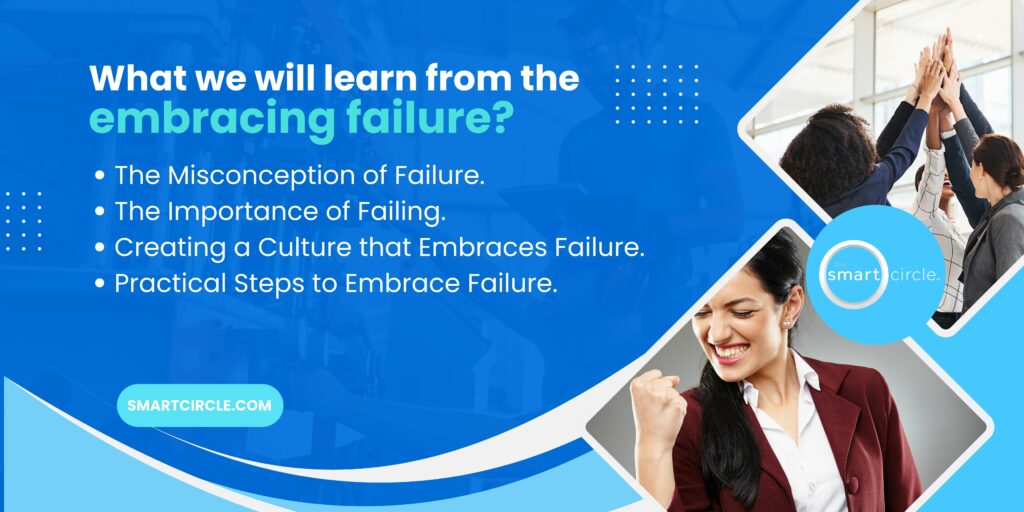In our society, failure is often seen as a negative outcome. Something to be avoided at all costs. The problem is that this perception creates a fear of failure, which hinders innovation.
But what if we shifted our perspective? What if we embraced failure as a crucial part of the journey to success? Giving ourselves permission to fail can lead to significant growth. In fact, according to research, to be successful you’ll need to fail 16% of the time. Embracing failure allows us to learn, adapt and ultimately succeed.

The Misconception of Failure
Many of history’s most successful individuals and businesses have faced numerous failures before achieving their goals. Thomas Edison, for example, made thousands of unsuccessful attempts at creating the light bulb before finally getting it right. These failures were not setbacks! They were learning experiences.
The fear of failure can be paralyzing. It prevents people from taking risks and pursuing their dreams. This fear is often rooted in a societal stigma that equates failure with inadequacy. In both personal and professional lives, this mindset can stifle creativity and progress.
To overcome this, we need to reframe failure as a learning opportunity. Each failure provides valuable insights and lessons that can inform future efforts. Viewing failure through this lens can transform it from a source of shame into a stepping stone towards success.
The Importance of Failing
It may sound shocking, but failure is one of the most effective teachers. When we fail, we gain new insights and develop skills that we might not have acquired otherwise. These lessons often pave the way for future successes. For example, J.K. Rowling faced numerous rejections before the Harry Potter series became a global phenomenon.
Resilience is built through facing and overcoming failures. Each time we fail and pick ourselves up, we become more adaptable and stronger. This resilience becomes a powerful tool in both personal and professional settings. It allows us to navigate challenges and persist in the face of adversity.
Many groundbreaking innovations have emerged from failures. Let’s look at something found in almost every single office: Post-It Notes. Did you know that the creation of these sticky notes was the result of a failed adhesive experiment? Embracing failure encourages experimentation and risk-taking, which are essential.
Creating a Culture that Embraces Failure
Leaders play a pivotal role in creating a culture that embraces failure. By sharing their own failures, they can set an example for their teams. This openness can help normalize failure and reduce the associated stigma.
Creating a supportive environment where employees feel safe to take risks is crucial. This involves encouraging open communication, celebrating efforts regardless of the outcome, and providing constructive feedback. When employees know they won’t be punished for failing, they are more likely to push boundaries.
A culture of continuous learning and experimentation is vital. Organizations should promote ongoing education and skills development, encouraging employees to view failures as opportunities for growth. This approach helps retain talent and create a dynamic and engaging work environment.
Practical Steps to Embrace Failure
Set Realistic Goals
Setting achievable goals is important for creating an environment where failure is seen as part of the learning process. Here’s how you can do it:
Define Clear Objectives
Make sure that your goals adhere to the SMART method, which stands for:
- Specific
- Measurable
- Achievable
- Relevant
- Time-bound
Example: Instead of setting a vague goal like ‘Improve sales,’ set a specific goal like ‘Increase sales by 10% in the next quarter.’
Include Room for Failure
Acknowledge that not all goals will be met on the first attempt. This mindset allows for flexibility and encourages experimentation.
Example: Set a goal to launch three new product features in the next six months, understanding that not all features may succeed initially.
Reflect and Learn
Reflection is key to learning from failures. By analyzing what went wrong, individuals and teams can gain valuable insights. Here’s how to do it effectively:
Conduct Post-Mortems
After a project or task, gather the team to discuss what worked and what didn’t. Focus on identifying key learnings rather than placing blame.
Example: After a failed marketing campaign, hold a debrief meeting to analyze the campaign’s performance metrics, audience feedback and areas for improvement.
Document Lessons Learned
Keep a record of failures and then lessons learned from them. This documentation can serve as a reference for future projects.
Example: Create a shared document or a database where team members can log their experiences and insights from failed projects.
Encourage Risk-Taking
Encouraging calculated risks is an effective way to learn from failure. Here’s how to promote risk-taking in your organization:
Reward Innovative Thinking
Recognize and celebrate team members who propose and implement new ideas, even if they don’t always succeed.
Example: Establish an ‘Innovation of the Month’ award to celebrate employees who take bold steps, regardless of the outcome.
Create Opportunities for Experimentation
Allow employees to experiment with new ideas through pilot projects, hackathons, or dedicated innovation time.
Example: Allocate one day a month for employees to work on passion projects or innovative ideas that could benefit the company.
Success Stories in Embracing failure
Elon Musk’s SpaceX failed multiple times before successfully launching a reusable rocket. Each failure provided crucial data that led to improvements and eventual success. Today, SpaceX is a leader in space exploration, thanks to its willingness to learn from failures.
James Dyson created over 5,000 prototypes of his vacuum cleaner before finding the perfect design. These failures were not in vain. They were steps forward creating a revolutionary product that changed the vacuum industry.
Closing Thoughts
The bottom line is that embracing failure is essential for personal and professional growth. By shifting our perspective, we can see failure as a valuable part of the learning process. Building resilience, fostering innovation and creating a supportive culture are all benefits of embracing failure.
Start viewing failure as a stepping stone to success. Whether you’re a business leader, an HR professional, or an employee, encourage a growth mindset and create an environment where failure is seen as an opportunity to learn and innovate. Embrace the freedom to fail, and watch how it transforms your journey to success.
Read More about: The Spark of Success: 6 Ways to Sustain Business Passion





